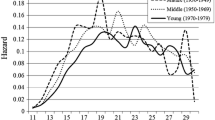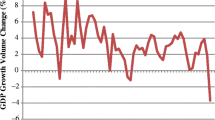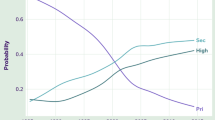Abstract
This article examines the link between early union formation and education using a new Canadian longitudinal data set, the Youth in Transition Survey (YITS). Educational transitions and early union formation occur around the same time in young adulthood, yet the roles of student and conjugal partner are often thought to be incompatible. We examine the effect of two important educational indicators (exit from full-time school and level of achieved education) on the timing of the first conjugal union. In addition, we incorporate several more direct measures of educational commitment. Results from proportional hazard models reveal that exit from full-time school greatly increases the transition to first union, especially marriage. Similarly, obtaining a post-secondary degree/diploma also significantly increases the risk of forming a union, especially for women. More direct measures of educational commitment show that skipping classes in high school has a negative effect on the risk of marriage, but a positive effect on cohabiting unions. A greater aspiration for future education, meanwhile, has a negative impact on union formation in general.
Résumé
Cet article examine les liens existant entre éducation et formation d’une union précoce à partir des données d’une nouvelle enquête longitudinale canadienne, l’Enquête auprès des jeunes en transition (EJET). Bien que les transitions associées à la trajectoire éducative et à l’entrée dans la vie de couple surviennent souvent autour du même moment dans la vie des jeunes adultes, les rôles d’étudiant et de partenaire conjugal sont souvent perçus comme étant incompatibles. Nous examinons ici l’effet que deux dimensions importantes de l’éducation, soit la fin des études à temps plein et le niveau d’éducation atteint, exercent sur le moment d’entrée en première union. Nous incorporons également dans l’analyse diverses mesures de l’engagement et des aspirations scolaires des jeunes. Les résultats issus des modèles à risques proportionnels révèlent que la fin des études à temps plein accroît grandement l’entrée en première union, en particulier par le biais du mariage. De même, l’obtention d’un diplôme post-secondaire accroît de façon significative le risque d’entrer en union, et ce surtout chez les femmes. Les mesures de l’engagement académique des jeunes montrent que le fait de manquer des cours à l’école secondaire a un effet négatif sur le risque de se marier, mais un effet positif sur le risque de former une union libre. Des aspirations scolaires plus élevées ont, par ailleurs, pour effet de retarder de manière générale la formation des couples.

Similar content being viewed by others
Notes
Their study was not restricted to a young sample however. They ran separate analyses by age group allowing for comparisons with younger samples.
In models that include a dummy variable to indicate the 1,375 missing cases the results do not vary from those without these cases and so we present analyses with them removed.
Respondents are in a union if they state they are married, or living with a partner (such as a common law partner or boyfriend or girlfriend).
Respondents who had not formed a union by Cycle 1 and who left the sample between cycles were censored at Cycle 1, while those who had not formed a union by Cycle 2, and were still in the sample, were censored at Cycle 2.
In other analyses not shown, we included all dependent children but these results did not appreciably differ from those presented.
The exact wording of the race question was “People in this country come from many different cultural or racial backgrounds. I’m going to read you a list. Are you White, Black, Chinese, etc?”.
We had more detailed information on country of birth; however, cell sizes were too small when analyzing this rare outcome (early union formation). Thus, we opted for the more simplistic, yet robust indicator of whether they were born in Canada or not.
In results (not shown) that include language but not province of high school, the language effect is stronger. Yet, each elicits an independent effect and is asked at two separate phases of the life course; therefore both are included.
The Ontario secondary school education system was reformed in 2003 when grade 13 was amalgamated with grade 12.
Our strong results may be somewhat overstated since, unlike Coppola (2004) we did not control for the endogeneity between education and union formation.
References
Baizán, P., Aassve, A., & Billari, F. C. (2003). Cohabitation, marriage, and first birth: The interrelationship of family formation events in Spain. European Journal of Population, 19, 147–169.
Becker, G. S. (1981). A treatise on the family. Cambridge, Mass: Harvard University Press.
Blossfeld, H. P., Hamerle, A., & Mayer, K. U. (1989). Event history analysis. Hillsdale, New Jersey: Erlbaum.
Blossfeld, H. P., & Huinink, J. (1991). Human capital investments or norms of role transitions? How women’s schooling and career affect the process of family formation. American Journal of Sociology, 97, 143–168.
Blossfeld, H. P., & Jaenichen, U. (1992). Educational expansion and changes in women’s entry into marriage and motherhood in the Federal Republic of Germany. Journal of Marriage and the Family, 54(2), 302–315.
Bowlby, J. W., & McMullen, K. (2002). At a crossroads: First results for the 18 to 20-year-old cohort of the youth in transition survey. Human Resources Development Canada and Statistics Canada, Ottawa, 81-591-XPE.
Bracher, M., & Santow, G. (1998). Economic independence and union formation in Sweden. Population Studies, 52, 275–294.
Brooks, R. (2003). Young people’s higher education choices: The role of family and friends. British Journal of Sociology of Education, 24(3), 283–297.
Buchmann, C., & DiPrete, T. A. (2006). The growing female advantage in college completion: The role of family background and academic achievement. American Sociological Review, 71, 515–541.
Caldwell, J. C., & Schindlmayr, T. (2003). Explanations of the fertility crisis in modern societies: A search for commonalities. Population Studies, 57(3), 241–263.
Cartwright, F., & Allen, M. K. (2002). Understanding the rural–urban reading gap. Ottawa: Human Resources Development Canada and Statistics Canada, 81-595-MIE.
Clark, W. (2000). 100 Years of education. Canadian Social Trends, Winter, 3–7.
Clarkberg, M. (1999). The price of partnering: The role of economic well-being in young adults’ first union experiences. Social Forces, 77(3), 945–968.
Clarkberg, M., Stolzenberg, R. M., & Waite, L. J. (1995). Attitudes, values, and entrance into cohabitational versus marital unions. Social Forces, 74(2), 609–632.
Coppola, L. (2004). Education and union formation as simultaneous processes in Italy and Spain. European Journal of Population, 20, 219–250.
Cox, D. R. (1972). Regression models and life tables (with discussion). Journal of the Royal Statistical Society, Series B, 34, 187–220.
Downey, D. B. (1995). When bigger is not better: Family size, parental resources, and children’s educational performance. American Sociological Review, 60, 746–761.
Glick, J. E., Ruf, S. D., White, M. J., & Goldscheider, F. (2006). Educational engagement and early family formation: Differences by ethnicity and generation. Social Forces, 84(3), 1391–1415.
Goldscheider, F. K., Hogan, D., & Turcotte, P. (2006). The other partner: The changing role of good provider for men’s union formation in industrialized countries. Canadian Studies in Population, 33(1), 25–48.
Goldscheider, F. K., & Waite, L. J. (1986). Sex differences in the entry into marriage. American Journal of Sociology, 92, 91–109.
Guzzo, K. B. (2006). The relationship between life course events and union formation. Social Science Research, 35, 384–408.
Hagan, J., MacMillan, R., & Wheaton, B. (1996). New kid in town: Social capital and the life course effects of family migration on children. American Sociological Review, 61, 368–385.
Hoem, J. M. (1986). The impact of education on modern family-union initiation. European Journal of Population, 2, 113–133.
Kandel, D. B., & Lesser, G. S. (1969). Parental and peer influence on educational plans of adolescents. American Sociological Review, 34(2), 213–223.
Kohler, H. P., Billari, F., & Ortega, J. A. (2002). The emergence of lowest-low fertility in Europe during the 1990s. Population and Development Review, 28(4), 641–680.
Le Bourdais, C., & Lapierre-Adamcyk, É. (2004). Changes in conjugal life in Canada: Is cohabitation progressively replacing marriage?. Journal of Marriage and the Family, 66(4), 929–942.
Liefbroer, A. C., & Corijn, M. (1999). Who, what, where and when? Specifying the impact of educational attainment and labour force participation on family formation. European Journal of Population, 15, 45–75.
Marini, M. M. (1984). Women’s educational attainment and the timing of entry into parenthood. American Sociological Review, 49(4), 491–511.
McNeal, R. B. Jr. (1999). Parental involvement as social capital: Differential effectiveness on science achievement, truancy, and dropping out. Social Forces, 78(1), 117–144.
Mitchell, B. A. (2001). Ethnocultural reproduction and attitudes towards cohabiting relationships. Canadian Review of Sociology and Anthropology, 38(4), 391–413.
Oppenheimer, V. K. (1988). A theory of marriage timing. American Journal of Sociology, 94, 563–591.
Oppenheimer, V. K. (2003). Cohabiting and marriage during young men’s career development process. Demography, 40(1), 127–149.
Ravanera, Z. R., Fernando, R., & Burch, T. K. (1998). Early life transitions of Canadian women: A cohort analysis of timing, sequences, and variations. European Journal of Population, 14, 179–204.
Ravanera, Z. R., Fernando, R., Burch, T. K., & Le Bourdais, C. (2002). The early life courses of Canadian men: Analysis of timing and sequences of events. Canadian Studies in Population, 29(2), 293–312.
Rendall, M. S., Clarke, L., Peters, E., Ranjit, N., & Verropoulou, G. (1999). Incomplete reporting of men’s fertility in the United States and Britain. Demography, 36, 135–144.
Rindfuss, R. R. (1991). The young adult years: Diversity, structural change and fertility. Demography, 28, 493–512.
Rindfuss, R. R., Guzzo, K. B., & Morgan, S. P. (2003). The changing institutional context of low fertility. Population Research and Policy Review, 22, 411–438.
Rindfuss, R. R., Swicegood, C. G., & Rosenfeld, R. A. (1987). Disorder in the life course: How common and does it matter? American Sociological Review, 52(6), 785–801.
Roscigno, V. J., & Crowley, M. L. (2005). Rurality, institutional disadvantage, and achievement/attainment. Rural Sociology, 66, 268–292.
Seltzer, V. C., & Waterman, R. P. (1996). A cross-national study of adolescent peer concordance on issues of the future. Journal of Research on Adolescence, 11(4), 461–482.
Snyder, A. R., Brown, S. L., & Condo, E. P. (2004). Residential differences in family formation: The significance of cohabitation. Rural Sociology, 69, 235–260.
StataCorp. (2005). Stata Statistical Software: Release 9. College Station, Texas: StataCorp LP.
Statistics Canada. (2003). Youth in transition 18–20 year old user guide-cycle 1. Ottawa: Human Resources Development Canada and Statistics Canada.
Thornton, A, Axinn, W. G., & Teachman, J. D. (1995). The influence of school enrollment and accumulation on cohabitation and marriage in early adulthood. American Sociological Review, 60(5), 762–774.
Trent, K. (1994). Family context and adolescents’ expectations about marriage, fertility, and nonmarital childbearing. Social Science Quarterly, 75(2), 319–339.
Turcotte, P, & Bélanger, A. (1997). Moving in together: The formation of first common-law unions. Canadian Social Trends, Winter, 7–10.
Turcotte, P., & Goldscheider, F. K. (1998). Evolution of factors influencing first union formation in Canada. Canadian Studies in Population, 25(2), 145–173.
Turner, K. M. (2004). Young women’s views on teenage motherhood: A possible explanation for the relationship between socio-economic background and teenage pregnancy outcome? Journal of Youth Studies, 7(2), 221–238.
Waite, L. J., & Spitze, G. D. (1981). Young women’s transition to marriage. Demography, 18, 681–694.
Wanner, R. A. (1999). Expansion and ascription: Trends in educational opportunity in Canada, 1920–1994. The Canadian Review of Sociology and Anthropology, 36(3), 409–442.
Xie, Y., Raymo, J., Goyette, K., & Thornton, A. (2003). Economic potential and entry in marriage and cohabitation. Demography, 40, 351–367.
Zeman, K., Knighton, T., & Bussière, P. (2004). Education and labour market pathways of young Canadians between age 20 and 22: An overview. Ottawa: Human Resources Development Canada and Statistics Canada, 81-595-MIE.
Acknowledgements
Support for this research was provided by the Social Science and Humanities Research Council and the McGill Canada Research Chair on Social Statistics and Family Change. We would like to thank the participants of the IUSSP Transition to Adulthood workshop, as well as Benoît Laplante for helpful comments.
Author information
Authors and Affiliations
Corresponding author
Additional information
The analysis is based on research carried out in the Quebec Inter-University Centre for Social Statistics, which provides researchers with access to detailed longitudinal survey data collected by Statistics Canada. The opinions expressed here do not represent the views of Statistics Canada.
Rights and permissions
About this article
Cite this article
Hango, D.W., Le Bourdais, C. Early Union Formation in Canada: Links with Education. Eur J Population 23, 339–368 (2007). https://doi.org/10.1007/s10680-007-9129-3
Received:
Accepted:
Published:
Issue Date:
DOI: https://doi.org/10.1007/s10680-007-9129-3




